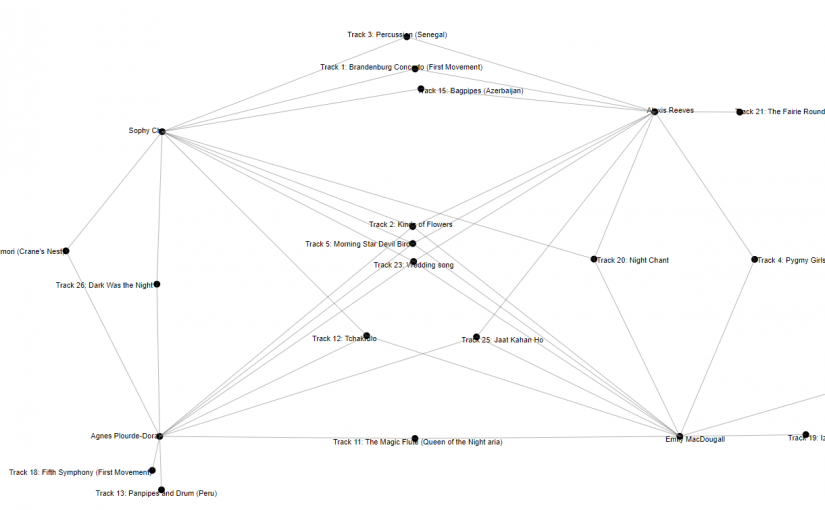It is interesting to think of the future as known and the past is ever-changing and dependent on context of what is preserved and what is not (Brown University, 2017).
Though scholars did try to include music from various cultures, languages and time-periods, the current track selection on the Golden Record reflected an intellectual monoculture that is very much Western and male-dominated.
As I curated the playlist into 10 tracks, I wanted to reflect:
- geographical and cultural diversity of music around the globe
- include both vocal and instrumental components of the songs
- contents of the songs reflect conceptual aspects of human civilization
Bach, Brandenburg Concerto No. 2 in F. First Movement
Location: Europe
Musical Content: Orchestra
Conceptual Aspects: as mentioned by Ferris, the mathematical foundations in this piece may be deciphered, given that the extraterrestrial life forms may have other ways of perception than that of humans. I think it also showcases the complexity and organization in orchestral pieces.
Peru, wedding song, recorded by John Cohen. 0:38
Location: South America
Musical Content: female vocals
Conceptual Aspects: Rituals and social norms surrounding “coming of age”, “fertility” and “reproduction” and the important role of such ceremonies across different cultures
Georgian S.S.R., chorus, “Tchakrulo,” collected by Radio Moscow. 2:18
Location: Eurasia
Musical Content: male vocals
Conceptual Aspects: the song is a drinking song in preparation for battle, reflection of war and conflict as an integral part of the rise and fall of civilizations throughout history. In addition, it highlights the cultural significance that “alcohol” plays in many cultures
Java, court gamelan, “Kinds of Flowers,” recorded by Robert Brown. 4:43
Location: Southeast Asia
Musical Content: gamelan, vocals
Conceptual Aspects: Connections to the different spiritual and philosophical states as represented through the relationship humans have with nature.
Australia, Aborigine songs, “Morning Star” and “Devil Bird,” recorded by Sandra LeBrun Holmes. 1:26
Location: Oceania
Musical Content: Vocals, Didgeridoo, unknown percussion instrument
Conceptual Aspects: After some research, there seems to be a mistake in the description, as the song that “Morning Star” cuts off into is not “Devil Bird” but another piece called “Moikoi”. Morning Star is a piece about the journey souls make after death; Moikoi is about “malicious spirits who entice newly deceased souls away from their clan country”, and “perhaps can be read as a message about the journey of the human spirit between Earth and space” (Rosen, 2013).
Japan, “Tsuru No Sugomori” (“Crane’s Nest,”) performed by Goro Yamaguchi. 4:51
Location: East Asia
Musical Content: shakuhachi
Conceptual Aspects: this song depicts the various stages in the life cycle of the crane, which symbolizes longevity in many East Asian cultures. The piece is thought to emphasize the Buddhistic values of affection between family members. Given that context, I think it shows the natural cycle of life and death of life forms on Earth, in addition to the values that can be learned from nature. Another note is that the techniques used to play the piece mimic the wing flutters and cries of the crane, which is demonstrative of “life imitates art, art imitates life”.
“Dark Was the Night,” written and performed by Blind Willie Johnson. 3:15
Location: North America
Musical Content: vocals, guitar
Conceptual Aspects: according to Ferris, the song was included because “Johnson’s song concerns a situation he faced many times: nightfall with no place to sleep. Since humans appeared on Earth, the shroud of night has yet to fall without touching a man or woman in the same plight.” (Sagan, 1978). I think this speaks to the difference in socio-economical statuses around the world and the affects of poverty, and on a more relevant note, inaccessible housing in the recent times.
Azerbaijan S.S.R., bagpipes, recorded by Radio Moscow. 2:30
Location: Eurasia
Musical Content: woodwind
Conceptual Aspect: I learned that this kind of composition includes classical poetry and musical improvisation, in which the scale and harmonics follow specific foundation of principles. Most of mugham songs are concerned with themes relating to spiritual search for god. I think that speaks to the importance and ubiquity of religion in civilization.
Navajo Indians, Night Chant, recorded by Willard Rhodes. 0:57
Location: North America
Musical Content: vocals
Conceptual Aspect: the song is part of a dance in which the Navajo medicine man call upon Yeibichai, the supernatural beings that created them, to heal someone. I think this shows communal healing as integral aspect of medicine, health and well-being, communal responsibility and aid during times of disease and sickness.
Alima Song” – Mbuti of the Ituri Rainforest
Location: Africa
Musical Content: vocals, percussion
Conceptual Aspects: I learned that the Mbuti people are nomadic people living in the rainforest in societies with no chiefs or leaders and share responsibilities amongst themselves. The song is composed by each individual singing one or two notes in circulation building up to a harmony.
Reflection
This was a very challenging task to approach — the responsibility of creating such a time capsule of humanity for extraterrestrial life-forms feels like a heavy burden upon my shoulders!
While listening to the Twenty Thousand Hertz Podcast introducing the Golden Record, I found it comforting to hear that even the scientists had a difficult time curating the record, and acknowledged that “you are automatically going to exclude almost all of the great music because there’s so much of it.”
Abby Smith in her lecture on digital memory and information preservation also mentions:
"When we think about what we want to preserve, inscribing our memory and outsourcing it into physical objects that we have no control over, we do lose some responsibility for the materials that we actually have." ( Brown University, 2017)
As we send out the Golden Record into the void, it is unclear how extraterrestrial life forms will understand or interpret our messages, and in some cases, it is out of our control.
With this new-found reassurance, I realized that regardless of what I include or exclude, it will still capture a sliver of humanity, even in its most pixelated and grainiest verisimilitude.
References
Brown University. (2017, July 11). Abby Smith Rumsey: “Digital Memory: What Can We Afford to Lose?” https://www.youtube.com/watch?v=FBrahqg9ZMc
Contents of the Voyager Golden Record. (2022). In Wikipedia. https://en.wikipedia.org/w/index.php?title=Contents_of_the_Voyager_Golden_Record&oldid=1094094672
Music of the ituri forest. Smithsonian Folkways Recordings. (n.d.). Retrieved July 10, 2022, from https://folkways.si.edu/music-of-the-ituri-forest/world/album/smithsonian
Nelson, R. (n.d.). The International Shakuhachi Society. Retrieved July 10, 2022, from https://www.komuso.com/pieces/pieces.pl?piece=2218
Rosen, R. J. (2013, November 13). Is the official description of the Aboriginal music on the Voyager Records Wrong? The Atlantic. Retrieved July 10, 2022, from https://www.theatlantic.com/technology/archive/2013/11/is-the-official-description-of-the-aboriginal-music-on-the-voyager-records-wrong/280676/
Sagan, Carl (1978). Murmurs of Earth : the Voyager interstellar record (1st ed.). Random House. p. 178. ISBN 0-394-41047-5.
Twenty Thousand Hertz. (n.d.) Voyager Golden Record. [Audio podcast episode]. Megaphone. https://cms.megaphone.fm/channel/20k?selected=TTH4214315391




